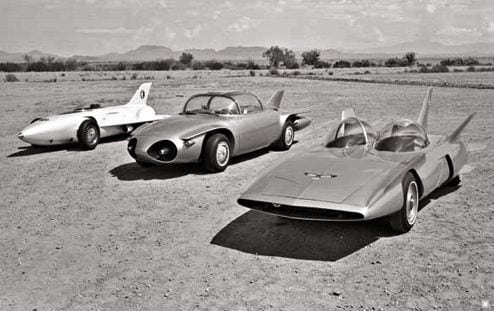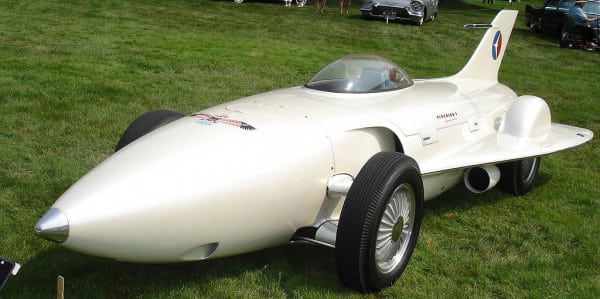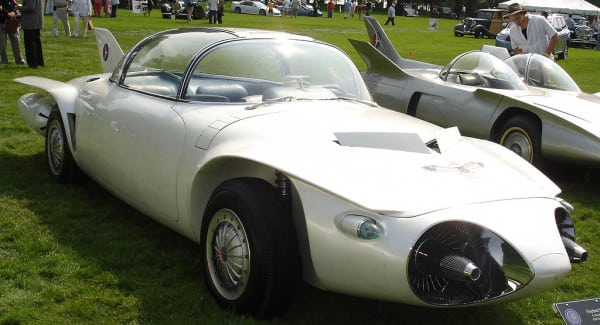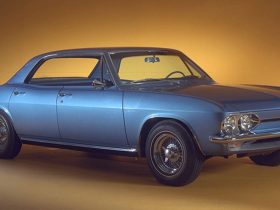In 1953, General Motors debuted what amounted to a jet plane on wheels at the Motorama auto show. Designed by Harley Earl, it was the first of three Firebird concepts that the company would showcase at the 1953, 1956, and 1959 Motorama shows. They were destined to become three iconic concept vehicles that would be enduring showcases of Earl’s lifelong obsession with aircraft. They would also be the short-lived foray by GM into gas turbine engines for consumer vehicles, appearing years before the infamous Chrysler Turbine.
All three Firebird designs were progressively more production-ready, though the concepts never actually made it to showrooms. The Firebird name was later revived (pun intended) by GM’s Pontiac sub-brand to become one of the most enduring sports cars in American history, though the production car and its earlier concept counterparts had absolutely nothing in common outside of the name.
The Firebird I, 1953
Since the 1930s, General Motors had been working on the idea of gas turbines with the actual engine being built by project lead Emmett Conklin, an engineer with a well-earned reputation for far thinking. His engine was eventually deemed ready enough to be tried in a car and Harley Earl was put to the task of building one.
The Firebird XP-21, later renamed the Firebird I, was born. Earl’s design inspirations appear to be a combination of the jet fighter aircraft of the day and rifle ammunition. The bullet-shaped, single-seater (in aircraft cockpit-style) rocket on wheels was about as practical as an umbrella in a wind storm.
The nose cone was clearly straight off of a 1950s fighter jet, almost an exact replica of the nose of something like the Lockheed XF-90 or McDonnell XF-88 Voodoo. Behind the front wheels, intakes were also obviously copied from jet aircraft as was the bubble cockpit. “Wings” adorned the sides to form high running boards that became wheel wells around the rear wheels. A stabilizing fin jutted up at the center of the rear deck, below which the huge exhaust for the turbine was opened. The wheels on the Firebird I were finned to look like turbine intakes on a jet engine.
Conklin was the only person on GM’s build staff qualified to drive the car, so he took it out and brought it up to 100 mph, at which point he shifted into second and nearly lost all control when the torque broke his tire traction. Later, the car was put on the Indianapolis Speedway and race driver Mauri Rose was seated in the cockpit. It proved entirely impractical for racing and had questionable stopping power, but at least proved that the turbine could propel a car.
The Firebird I output 370 horsepower with its Whirlfire Turbo Power engine and two-speed shifting. Jet exhaust exited the back of the little rocket at about 1,250° F (677° C). The car weighed only 2,500 pounds at the curb.
The Firebird II
The team went back to the drawing board to work on engine and vehicle design improvements. In order for GM to continue interest in the idea of turbine engines, a more workable, practical car would have to be shown. In 1956, the Firebird II four-seater debuted at Motorama.
Several new ideas and highly advanced improvements were showcased in this rendition of the turbine concept. The Firebird II was actually less practical than the first concept in terms of production, but was far more advanced in every other way.
Sitting wide and low, the Firebird II’s front end is dominated by two huge turbine-styled intakes. The elongated cylinder-shaped body has wing-like juts for fenders around all four wheels, tiny beady-eyed round headlamps poking out from the front corners, behind the intakes, and a long, sloped hood that includes two air brake wings at front and center. The bubble canopy is much wider and larger, with chromed supports all around. The passenger compartment seats four, all clearly visible through the glass dome. A stabilizing fin holds over from the first concept at the center of the deck and smaller, but no less jet-like exhaust vents dominate the rear end. Most of the bodywork is made of titanium, which made it both incredibly expensive and highly impractical for production, but was a huge step up from the weighty and shaky fiberglass of Firebird I.
Firebird II was longer, at 120 inches in wheelbase. Under that titanium shell, however, was where the real action was happening with this new rendition of the turbine concept.
Engine output was decreased to 200 horses, but now the exhaust was recirculated and fed out on a longer route, resulting in tailpipe temperatures of not quite 300°F. The circulating exhaust was used to power accessories, further saving engineering efforts to figure out how to spin accessory items from the fast-moving turbine. Four-wheel disc brakes and a fully-independent suspension were also marked improvements on the Firebird II design.
More tellinggly, the 1956 Firebird II had a sophisticated (and working) “highway guidance system”, a part of a joint development venture in the automotive industry, that could catch the signal from a guide wire embedded in the freeway to allow the car to pilot itself and relieve the driver of responsibility, keeping all cars on the road safe from accidents as they drove on autopilot to their destination exit. This idea of automated driving was the theme of the 1956 Motorama. A television screen showing highway and weather information also foretold today’s GPS systems and their connectivity.
The Firebird III
The final rise of the Firebird series of concepts was with the 1958 Firebird III, shocased at the 1959 Motorama. It became slightly more production-ready, at least in theme, but still retained the titanium bodywork and was now in a less practical 2-seat, double-bubble canopy. The flattened, peaked hood, mouth-like long oval front grille opening covering the entire front end, and ferocious-looking wing-like projections all around made this concept more far-fetched than even the original.
Yet this rendition had consumer-ready features like cruise control, air conditioning, anti-lock brakes (supplemented by air drag brakes on the body), and one of the first versions of “remote keyless entry” via its “supersonic key” which signaled the doors to open.
Described as “shark like” by many, this wide, low and relatively flat car did have many features of a shark in the water. The rear “wings” look more like fins sticking out to stabilize in a gliding motion while the thin, wide grille opening and protruding fender “wings” add a sinister look. All of these things were heavily tested in the wind tunnel, however, and found to be stabilizing and aerodynamically sound by Earl and crew.
The car contained the latest Whirlfire GT-305 gas turbine putting out 225 horsepower. This was supplemented by a tiny 10 horsepower gasoline engine which powered the accessories, the team having given up on running all of those goodies on turbine exhaust alone. Like its predecessor, the Firebird III had low-temperature emissions and the same automated guidance system, upgraded now to include a joystick between the seats rather than a steering wheel and column.
Where Are They Now?
All three Firebird concepts are still owned by General Motors and are often showcased at their Museum in Michigan as well as occasionally at classic car and concept shows. GM continues its turbine project today, though mainly for military and commercial applications.
The Firebird I as a small scale model appears on top of the Indianpolis 500 trophy to this day.
Video of Firebird I
Video of Firebird II
Videos of Firebird III
http://www.youtube.com/watch?v=3yHQ21PhlWM&feature=endscreen&NR=1











